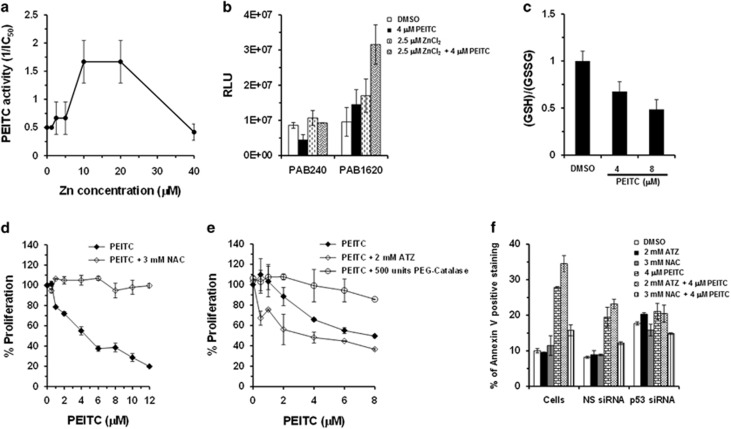Figure 6.
Effects of zinc and redox changes on PEITC-induced p53R175 reactivation. (a) Effect of zinc on the activity of PEITC. SK-BR-3 cells were treated with PEITC, zinc or both. Percentage of cell proliferation was determined by the WST-1 assay. The PEITC activity is shown as 1/IC50 for growth inhibition. (b) ELISA to determine the effect of zinc alone or zinc and PEITC on conformation of recombinant-purified GST-p53R175H by using conformation-specific antibodies PAB240 (mutant-specific) and PAB1620 (WT-specific). (c) Effect of PEITC on the levels of reduced glutathione in SK-BR-3 cells. SK-BR-3 cells were treated with PEITC (4 or 8 μM) or DMSO for 4 h. Ratio of reductant GSH and oxidative GSSG was then measured using the GSH/GSSG-Glo Glutathione Assay Kit. (d) Effect of NAC on PEITC activity. SK-BR-3 cells were treated with the indicated concentrations of PEITC or PEITC in combination with 3 mM NAC for 3 days. Percentage of cell proliferation was determined by the WST-1 assay. (e) SK-BR-3 cells were co-treated with the PEITC alone or in combination with 2 mM ATZ or 500 units PEG-Catalase for 3 days. Percentage of cell proliferation was determined by the WST-1 assay. (f) Effect on apoptosis. Untransfected (cells) or siRNA-transfected SK-BR-3 cells were treated with DMSO, ATZ, NAC or PEITC alone or PEITC in combination with ATZ or NAC for 3 days. Apoptosis was measured by Annexin-V staining using a BD LSRFORTESSA instrument

